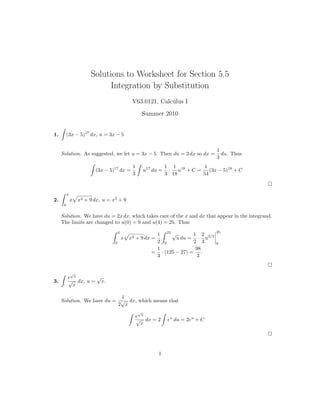
Lesson 28: Integration by Substitution (worksheet solutions)
- 1. Solutions to Worksheet for Section 5.5 Integration by Substitution V63.0121, Calculus I Summer 2010 1. (3x − 5)17 dx, u = 3x − 5 1 Solution. As suggested, we let u = 3x − 5. Then du = 3 dx so dx = du. Thus 3 1 1 1 18 1 (3x − 5)17 dx = u17 du = · u +C = (3x − 5)18 + C 3 3 18 54 4 2. x x2 + 9 dx, u = x2 + 9 0 Solution. We have du = 2x dx, which takes care of the x and dx that appear in the integrand. The limits are changed to u(0) = 9 and u(4) = 25. Thus 4 25 1 25 √ 1 2 x x2 + 9 dx = u du = · u3/2 0 2 9 2 3 9 1 98 = · (125 − 27) = . 3 3 √ e x √ 3. √ dx, u = x. x 1 Solution. We have du = √ dx, which means that 2 x √ e x √ dx = 2 eu du = 2eu + C x 1
- 2. cos 3x dx 4. , u = 5 + 2 sin 3x 5 + 2 sin 3x Solution. We have du = 6 cos 3x dx, so cos 3x dx 1 du 1 1 = = ln |u| + C = ln |5 + 2 sin 3x| + C 5 + 2 sin 3x 6 u 6 6 In these problems, you need to determine the substitution yourself. 5. (4 − 3x)7 dx. 1 Solution. Let u = 4 − 3x, so du = −3x dx and dx = − du. Thus 3 1 u8 1 (4 − 3x)7 dx = − u7 du = − + C = − (4 − 3x)8 + C 3 24 24 π/3 6. csc2 (5x) dx π/4 1 Solution. Let u = 5x, so du = 5 dx and dx = du. So 5 π/3 5π/3 1 csc2 (5x) dx = csc2 u du π/4 5 5π/4 5π/3 1 =− cot u 5 5π/4 1 5π 5π = cot − cot 5 4 3 √ 1 3 = 1+ 5 3 3 −1 7. x2 e3x dx 2
- 3. 1 Solution. Let u = 3x3 − 1, so du = 9x2 dx and dx = du. So 9 3 −1 1 1 x2 e3x dx = eu du = eu + C 9 9 1 3x3 −1 = e . 9 Sometimes there is more than one way to skin a cat: x 8. Find dx, both by long division and by substituting u = 1 + x. 1+x Solution. Long division yields x 1 =1− 1+x 1+x So x dx dx = x − 1+x 1+x To find the leftover integral, let u = 1 + x. Then du = dx and so dx du = = ln |u| + C 1+x u Therefore x dx = x − ln |x + 1| + C 1+x Making the substitution immediately gives du = dx and x = u − 1. So x u−1 1 dx = du = 1− du 1+x u u = u − ln |u| + C = x + 1 − ln |x + 1| + C It may appear that the two solutions are “different.” But the difference is a constant, and we know that antiderivatives are only unique up to addition of a constant. 2z dz , both by substituting u = z 2 + 1 and u = 3 9. Find √ 3 z 2 + 1. z2 + 1 3
- 4. Solution. In the first substitution, du = 2z dz and the integral becomes du 3 2/3 3 √ = u−1/3 du = u + C = (z 2 + 1)2/3 3 u 2 2 In the second, u3 = z 2 + 1 and 3u2 du = 2z dz. The integral becomes 3u2 3 3 3 du = 3u2 du = u + C = (z 2 + 1)2/3 + C. u 2 2 The second one is a dirtier substitution, but the integration is cleaner. Use the trigonometric identity cos 2α = cos2 α − sin2 α = 2 cos2 α − 1 = 1 − 2 sin2 α to find 10. sin2 x dx Solution. Using cos 2α = 1 − 2 sin2 α, we get 1 − cos 2α sin2 α = 2 So 1 1 sin2 x dx = − cos 2x dx 2 2 x 1 = − sin 2x + C. 2 4 11. cos2 x dx Solution. Using cos 2α = 2 cos2 α − 1, we get 1 + cos 2α sin2 α = 2 So 1 1 sin2 x dx = + cos 2x dx 2 2 x 1 = + sin 2x + C. 2 4 4
- 5. 12. Find sec x dx by multiplying the numerator and denominator by sec x + tan x. Solution. We have sec x(sec x + tan x) sec x dx = dx sec x + tan x sec2 x + sec x tan x = dx tan x + sec x Now notice the numerator is the derivative of the denominator. So the substitution u = tan x+sec x gives sec x dx = ln |sec x + tan x| + C. 5
